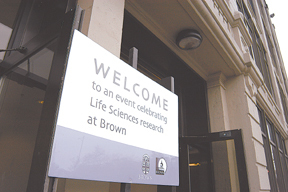Speaking at a reception celebrating the ongoing renovation of the Doran-Speidel
Building in the Jewelry District, U.S. Sen. Jack Reed might have described the
transformation best when noting that Twist-O-Flex technology has given way to
the double helix era.
Originally built in 1912, the five-story building at 70 Ship St. is named for the Speidel Chain Co., an early tenant who manufactured gold watch chains and the expandable watch bracelets of Reed’s memories. Brown University closed on the property in September for a purchase price of $14.6 million that included a 140-space parking lot across the street and is spending nearly $23 million on renovations to turn the space into state-of-the-art research labs.
Wandering around a gutted third floor the morning of Nov. 17, faculty, students, administrators and legislators gathered to see the progress of the project that is expected to be completed for next fall.
The building’s 105,000 square feet, along with Brown’s new Life Sciences Building (set to open in the spring of 2006), will increase the university’s life sciences lab space by 75 percent and marks the first major investment by Brown in more than a dozen years. As many as 150 researchers, including faculty, laboratory staff and student assistants will work in the building and conduct more than $10 million in yearly sponsored research.
Provost Robert Zimmer said the construction of the projects alone will generate hundreds of jobs over the next several years. And Zimmer said independent analysts have calculated that the Rhode Island economy will see $60 million in economic output from the combined research support, the purchase of goods and services to support research activities and spending from people employed in the two facilities.
Richard Besdine, interim dean of Brown Medical School, said the Ship Street facility will launch new research initiatives. Besdine noted that in the last decade Brown has seen the dollar-figure for sponsored research triple without any increase in faculty numbers or laboratory space. Last year, those research dollars passed $120 million and he said the university is on track to exceed that amount this year.
As he recounted his trips into the city along Route 195, Besdine recalled regularly reading the 40-foot high “For Rent” banner on the building.
“Space was our biggest challenge,” said Besdine, joking that it only took him 42 commutes to begin considering the possibility of taking the space.
The Speidel building is just the latest building in the Jewelry District, just south of the city’s center, to be tabbed for biomedical work.
Women & Infants’ Hospital is at work in the Kilguss Research Center on Chestnut Street and other nearby labs include the Galletti Building on Claverick Street (owned by the Lifespan health system and Brown), and the Coro Building on Point Street (also owned by Lifespan).
Providence Mayor David Cicilline echoed talk of the “intellectual capital” hubs that can be found on Route 128 in Boston, “This is the beginning of that kind of cluster,” he said.












